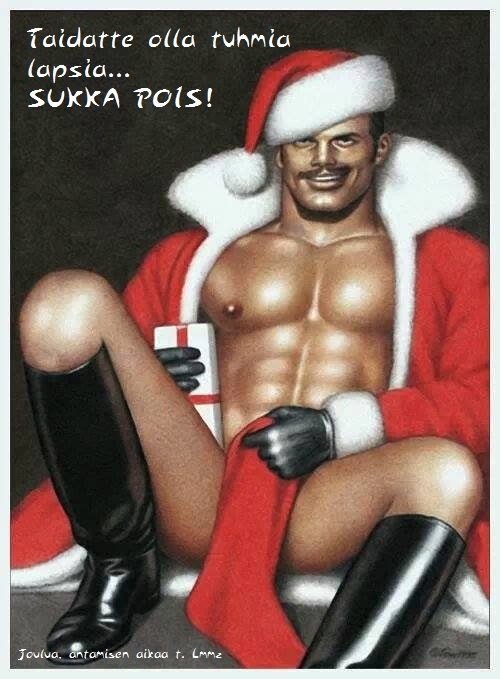Home › Forum Online Discussion › General › Was Santa Claus originally a shaman? (Newsletter)
- This topic has 2 replies, 3 voices, and was last updated 9 years, 10 months ago by
c_howdy.
-
AuthorPosts
-
December 21, 2015 at 2:34 pm #45529
Was Santa Claus originally a shaman from Lappland? You decide after viewing the evidence. 🙂
Enjoy your Winter Solstice, and the Dark Goddess who originates the birthing of the gift of Creation itself.
https://www.michaelwinn.qlogictechnologies.com/cgi-bin/articles.pl?rm=mode2&articleid=204
December 22, 2015 at 8:45 am #45530
AnonymousDid the Shaman really fly away to escape the missionaries?
December 27, 2015 at 12:52 am #45532BY REID STANDISH, DECEMBER 24, 2015
HELSINKI With just five hours of daylight in the south and perpetual night in the north, December may be the darkest month in Finland, but its when the country gets its chance to shine. As most Finns will proudly report, the Finnish word for December, Joulukuu, literally translates to Christmas month, and every year, from the Baltic Sea to the Arctic Circle, Finns erect massive trees at their holiday markets, bake gingerbread cookies en masse, brew mulled wine by the liter and then sit back and wait for the hordes to arrive.
Come December, visitors from all across the world Australia, Britain, Spain, Russia, China, Japan flock by the thousands to Finland: the official home of Santa Claus (according to the Finnish government, anyway).
Since the 1980s, Finland has built a thriving industry around its claims to be the resident home of the jolly gift-giver. There have been rivals: Alaska, Greenland, Norway, and Sweden have all attempted to declare that their northern reaches are the real home of Christmas central. But none have managed to make their claims stick quite like Finland, due in part to the robust support of the government, which over the years has happily plowed state resources into the Santa industry. Rovaniemi, the northern town that serves at the epicenter of Finlands Santa industry, attracts more than 300,000 visitors annually; its closest competitor Mora, Sweden only sees some 50,000 visitors each year.
Rovaniemi population 58,000, latitude 66.5° is located in the northern region of Lapland, in the Arctic Circle. In December, windblown snow banks and a dimmed winter sky frame the snow-capped wooden buildings of Rovaniemis Santa Claus village, where tourists can meet Mr. Claus himself, tour the Santa amusement park, take a reindeer sleigh ride, mail a letter from a post office run by elves, and even catch the local soccer team FC Santa Claus take to the pitch.
In Finland, Christmas isnt just a holiday season its a source of national pride. It also happens to be big business.In Finland, Christmas isnt just a holiday season its a source of national pride. It also happens to be big business. Santa tourism remains a rare bright spot in a contracting Finnish economy, and a crucial source of livelihood for many living in Lapland where the other main industries are steel work and mining. Around 80,000 visitors are expected to visit the Santa office in Rovaniemi during the six-week high season around Christmas this year, a welcome increase after a post-2008 recession dip that hurt many Finns working in the vital tourism sector, who do 90 percent of their approximately $230 million (210 million euros) of annual business during the winter.
Its become a big industry thats been good for Finland, good for Lapland, and good for everyone who comes, Alexander Stubb, Finlands finance minister and former prime minister, told Foreign Policy from his offices overlooking Helsinkis bustling Christmas market in Senate Square. Being able to market Santa as a Finn living in Lapland is probably one of the best brands that you can have, because everyone loves Santa Claus.
The Christmas high season has even been extended so that the Santa-industrial complex can increasingly cater toward Finlands large neighbor to the east. Russia, whose own winter gift-giver is more closely associated with the New Year, celebrates Orthodox Christmas on Jan. 6. While Christmas season is the boom time, the attractions run throughout the year and tourists can still visit Santa Claus during the height of summer, swapping the aurora borealis for the midnight sun.
Today, the man that brings in all these tourists and their money is the version of Santa Claus that has come to be accepted around the globe: a jolly, bearded, big-bellied man clad in white and red. But Finlands Santa was not always thus.
Even though Christianity came to Finland at the end of the 12th century, Finns still celebrated Kekri, a pre-winter agricultural festival with pagan origins during which, amid eating and drinking, young men wearing goat masks, horns, and sheepskin coats would go from house to house asking for food and drink, and maybe even a stint in the sauna. The Kekri goat was a terrifying character, said Eija Stark, a Finnish folklore expert at the University of Helsinki. Treating him well meant that next years grain harvest would be plentiful. Kekrirelated traditions began to fade away in the 19th century, but left their trace in the Finnish name for Santa: Joulupukki, which translates as Christmas goat.
Even after Finland adopted the popular North American version of Santa Claus, he still wasnt all reindeer and presents. While upper-class Finns came around to the idea of a cheerful, smiling Santa, according to Stark, in the countryside, the pagan origins of the holiday still prevailed.
If children had been naughty during the year, the Christmas goat would whip them, Stark said. Oral histories from the 1950s from children in rural Finland attest to how scary some versions of Joulupukki were, Stark said: They often still dressed in sheepskin and wore horns.
It was a mixture of globalization and economic necessity that would complete the Christmas goats transformation from childhood scourge to national gold mine. Finland, which was aligned with Nazi Germany, was left devastated in the wake of World War II, the result of both fighting with the Soviet Union and the scorched-earth tactics of retreating German troops, which destroyed many settlements in the north, including Santas current home in Rovaniemi. When the city was rebuilt, it aimed to become a tourist hub, advertising breathtaking scenery and abundant nature. By 1957, the New York Times travel section had taken notice, giving the Lapland region a rave review. But the article made no mention of Santa Claus, and the city remained mostly a summer-time destination for European adventurers.
The seeds of the Santa business, however, had been planted decades earlier: Most believe the first reference to Finland as Santa Clauss permanent residence was in 1927 when Markus Rautio, a famous Finnish radio broadcaster, reportedly declared on-air that Santas workshop had been discovered in Laplands Korvatunturi, near the border with Russia. The claim managed to make a mark in the Finnish public imagination: Starting in 1960, each Dec. 23 (because Finns open presents the night of Christmas Eve) Finlands state broadcaster YLE began narrating in real time Santas departure from his cabin in the north, where he would hop in his reindeer-drawn sleigh Finnish Santas reindeer dont fly and leave to deliver presents around the world.
In December 1984, Finland finally decided to cash in on this unique asset. After years of debate, the Finnish Tourist Board, a state agency, set up a Santa Claus Work Group an exploratory committee in order to establish Santa Claus as an official tourism attraction. Shortly after, the governor of Lapland declared the entire province Santa Claus Land. By 1985, the plans were formalized: Santa would be the Finnish Tourist Boards new weapon for attracting tourists to the frozen north.Santa would be the Finnish Tourist Boards new weapon for attracting tourists to the frozen north.
According to Michael Pretes, a professor at the University of North Alabama and an expert on Nordic tourism, Finland was able to better its rivals for the Santa Claus crown in part due to the amount of state support for its claim. Finland seized the advantage in adopting Santa Claus, and ran with the idea before other countries realized what was happening, Pretes said.
To win hearts and minds overseas, according to Pretes, the tourism board sent Santas around the globe, from Beverly Hills to Dublin to Estonia and Japan even sending one to make an appearance with the Finnish national team at the closing ceremonies of the 1988 Summer Olympic Games in Seoul. Not all were pleased with Finlands growing Santa superpower status: In 1993, the mayor of Drobak, the northern Norwegian town that also claims to be Santas home, called on his fellow countrymen to take a stand against the King of Norways visit to Rovaniemi, arguing that it would support Finlands case.
Today, Rovaniemi seems to have solidly cemented its status as the place with the most popular, if not necessarily the most recognized claim on being the home of Santa. Meanwhile, Finlands Santa-Industrial Complex keeps churning: The big man made an appearance in Korea in early December and was spotted meeting his counterpart on the Russian border just last week all courtesy of the government of Finland.
http://www.youtube.com/watch?v=gxPMHu-XOnU

-
AuthorPosts
You must be logged in to reply to this topic.
